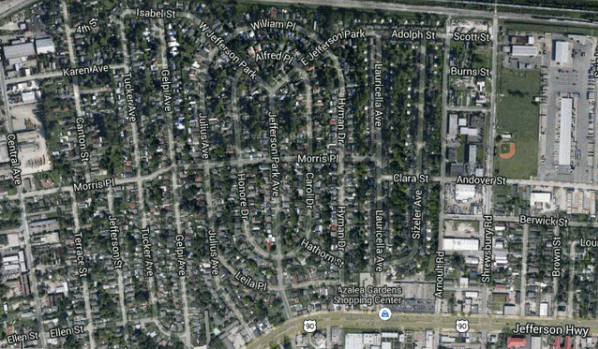|
Today in New Orleans History |
|
|
November 25


Actor John Laroquette was born in New Orleans on November 25, 1947.
Francisco Bouligny (full name: Francisco Domingo Joseph Bouligny),
soldier, administrator. Born, Alicante, Spain, September 4, 1736; son of Juan Bouligny, a Spanish
resident born in Marseilles, France, and María Paret. Secondary education at College of Orihuela. Appointed
cadet in infantry regiment of Zamora, February 1758; stationed in Havana from 1763 to summer 1769, when he joined O'Reilly's
expedition to Louisiana. While the ships waited at the mouth of the Mississippi, went in a small boat to New Orleans
to notify Aubry (q.v.), the former acting French governor,
of O'Reilly's arrival and to investigate and report on the city's reaction (July 1769); served as interpreter at the subsequent
trial of the insurrection leaders. Promoted to brevet captain and appointed adjutant of the newly formed Louisiana
Battalion, November 1769. Married, New Orleans, December 27,
1770, Marie Louise Le Sénéchal d'Auberville (1750-1834), daughter of Vincent Guillaume Le Sénéchal
d'Auberville (q.v.). Children: Marie Louise Joséphine
(b. 1771); Dominique (q.v.); Rémy (1774-1776); Louis
(q.v.); Céleste (1784-1787). Promoted to rank of full captain, October 1772. Accused of keeping unsatisfactory battalion
records and suspended, December 1773; reinstated, April 1774. Visited Spain 1775-1776; in August 1776 submitted to
Spanish government a lengthy Memoria describing the natural
resources, population, and exposed position of the colony of Louisiana, and making recommendations for remedial action.
This led to his appointment as lieutenant-governor of Louisiana in charge of new settlements, commerce, and Indian relations,
November 1776, a position he held until 1780. Promoted to rank of brevet lieutenant-colonel, August 1777. In
April 1779, under his authority over new settlements, founded New Iberia with settlers from Málaga, Spain.
Bouligny Plaza in New Iberia commemorates this event. In August 1779 left New Iberia with 40 men to join the military
force that Governor Gálvez (q.v.) had assembled
at Plaquemine; participated in the capture of Fort Bute de Manchac and Baton Rouge, September 1779. Participated in
siege of Mobile after visiting the fort under a flag of truce in an effort to persuade the British commander to surrender,
1780. At siege of Pensacola, 1781, led the assault on the outpost that had been breached, tearing down the enemy flag
with his own hands, 1781. In 1783, as acting military governor in the absence of Miró (q.v.), directed the operations leading to the capture of the St. Malo (q.v.) band of runaway slaves. Appointed full lieutenant-colonel, July 1785.
In command at Natchez to protect against a threatened attack from Georgia, 1785-1786. Appointed brevet colonel, August
1789. Promoted to rank of full colonel in command of the Louisiana Infantry Regiment, succeeding Pedro Piernas (q.v.), September 1791. Became acting governor for military affairs on death of Governor
Gayoso (q.v.), served July-September, 1799. Promoted
to rank of brigadier, September 1800. Died, New Orleans, November 25, 1800; interred St. Louis Cathedral.
F.M. Sources: Bouligny-Baldwin and Dauberville-Bouligny Papers, The Historic New Orleans Collection; Kuntz
Collection, Tulane; Gilbert C. Din, Louisiana in 1776: A Memoria of Francisco Bouligny (1977); Jack D. L. Holmes, "Dramatis Personae," Louisiana Studies, VI (1967); Maurine Bergerie, They Tasted Bayou Water: A Brief History
of Iberia Parish (1962); Alcée Fortier, A History
of Louisiana, Vol. II (1904). From http://lahistory.org/site19.php
Frank Fagot settled in Metairie around 1900 on some
200 acres. In 1911 he sold 87 acres to Fidelity Land Company which, with him, developed the first modern subdivision
in Jefferson Parish. Named Metairie Heights it consisted of 100 lots 25 feet-wide and 120 feet-deep. Frank, a major
stockholder, proclaimed that he would move his general merchandise store to a different location on the property and would
add another story to the building. (Times-Picayune photograph) As early as 1912 allegations were passed that Fagot
had been running a “blind tiger” (illegal bar with gambling) out of his store. That same year he ran for the
position as school director but was beaten by Alfred Bonnabel by eight votes. In 1913 he was appointed parish commissioner
of tax collection and advocated for a street railway to Kenner and New Orleans (the Orleans-Kenner Traction Company's
O-K line) which came to be in 1916 – in Metairie it was called the Royal Blue Line. (Photo Courtesy of the Louisiana
Digital Library.) In 1914 the 4th
class Metairie Post Office was established in Fagot's store with his wife, Florida I. Hanna, serving as Metairie's first
postmistress. In 1928 Governor Huey P. Long sent the National Guard to raid his Metairie Inn gambling hall, which was on
the second floor of his business which was built on his property bounded by Metairie Heights, Fagot Street, and Metairie
Road. Fagot leased the store to A&P in 1934. (Times-Picayune photograph) Jefferson
Park Race Track, opened in 1917, on the lake-side of Jefferson Highway between Arnoult Road and Central Avenue. It
was a premier course where the Louisiana Derby was inaugurated in 1920 when Damask won the 1 1/8-mile race, collecting
the whopping winner’s share of $4,975. The Orleans-Kenner/Royal Blue Line brought visitors to the track back
in the day before the track closed in the mid 1930s after owners Robert S. Eddy Jr., Joseph Cattarinich and associates
acquired the Fair Grounds in 1934 for $375,000. For sime time afterward the facilities were used for horse shows, school
picnics, fairs, fund-raisers, and the like. The track was demolished in 1942. Arnoult
and Riviere at Jefferson Park -- 1910 Descendants of two of the earliest pioneering
families in Metairie, George Riviere, son of Pierre Ernest, is shown here with Louis Edgard Arnoult (right) at the Jefferson
Racetrack in 1910. The Arnoults settled in 1827. The Rivieres came a decade later in 1836 when Metairie was still much
undeveloped. (Photo Courtesy of John “Jack” Schott.) Jefferson
Park Subdivision In 1948 new homes were for sale in Jefferson Park Subdivision.
The color photo shows the location. The outline of the old race track is clearly visible. |
|
|

To receive an update for each day in New Orleans history,
join our facebook page - Today in New
Orleans History.
Analytics |

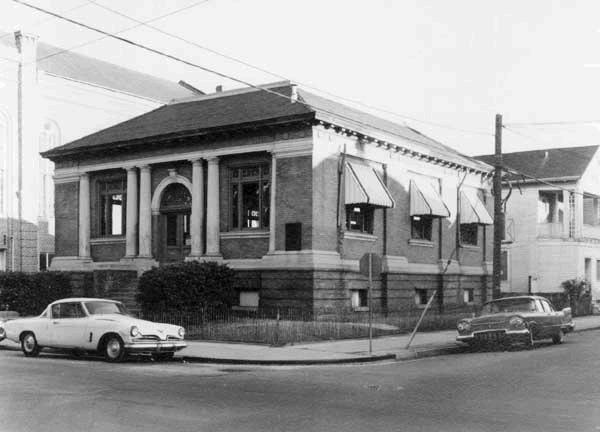


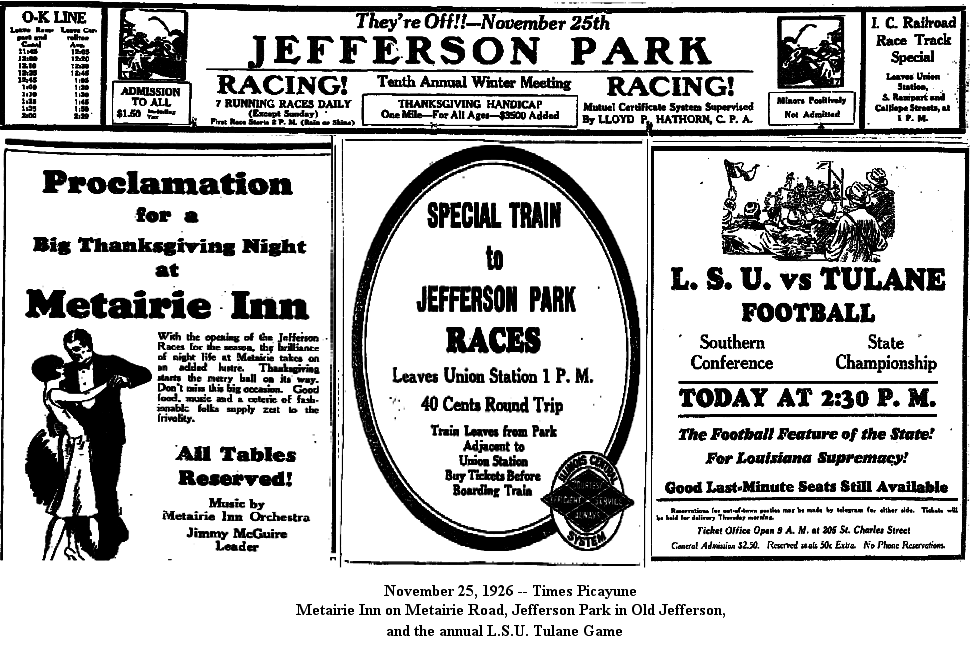
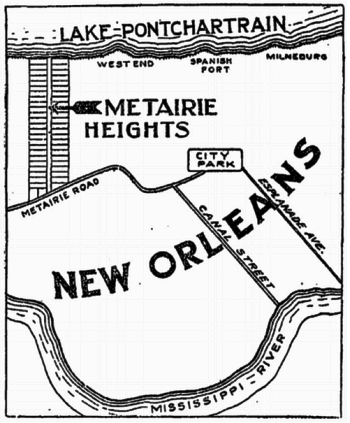 Frank Fagot's Metairie Inn
Frank Fagot's Metairie Inn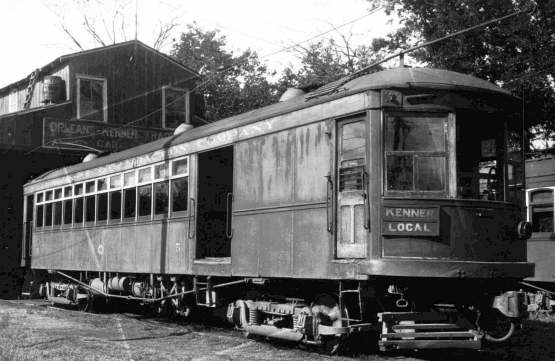 Streetcar Named Royal Blue
Streetcar Named Royal Blue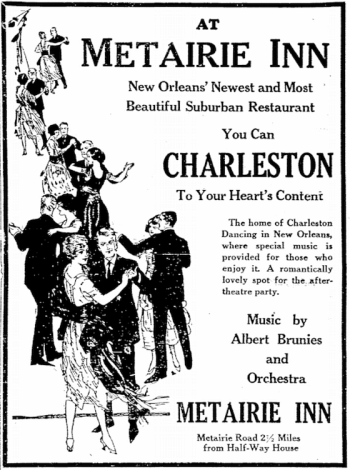 Metairie's First Post Office -- with Gambling Upstairs
Metairie's First Post Office -- with Gambling Upstairs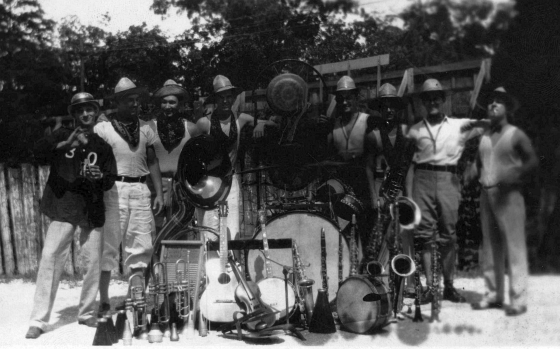
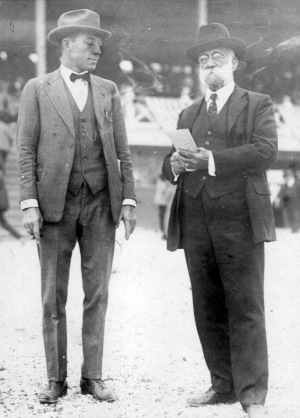 Jefferson Park Race Track
Jefferson Park Race Track 